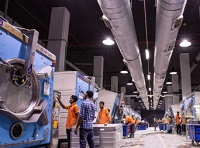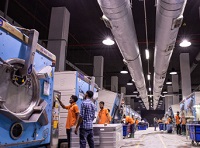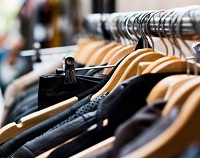FW
Jeanologia has conjured up a new sanitization technology for retailers. The brand has created Sanibox, a sanitization chamber with a viral deactivation level of 98 percent, can sanitize materials swiftly and safely through its combined ozone technology and humidity control that disinfects, eliminates bacteria and deactivates the COVID-19 virus.
Sanibox is available for purchase by retailers and can be used in both brick-and-mortar stores, as well as distribution centers for e-commerce businesses. But the story behind its technology began at the beginning of the coronavirus pandemic, when the Spanish government called upon Jeanologia to help sanitize protective facial masks for hospitals with its well-known proprietary ozone technology.
Sanibox’s wide-ranging applications include brick-and-mortar stores and distribution centers. The technology can also be used on apparel that was sent online to individuals, or [applied] to staff uniforms before use.
Sanibox has been certified by the CSIC and complies with AFNOR NFT 72-281, a French standard method that verifies the effectiveness of airborne surface disinfection systems and its utilized by the European Biocidal Product Regulation (BPR).
 Support for domestic apparel manufacturing in the US was growing even before the outbreak of COVID-19. However, with COVID-19 disrupting most supply chains, manufacturers are quickly shifting to local PPE manufacturing. SEAMS, the representative of manufacturers of sewn products in the US notes a growing desire amongst members to make and access PPE for healthcare workers and government organizations. Within a week, these manufacturers shifted their production to making face masks, gowns, etc.
Support for domestic apparel manufacturing in the US was growing even before the outbreak of COVID-19. However, with COVID-19 disrupting most supply chains, manufacturers are quickly shifting to local PPE manufacturing. SEAMS, the representative of manufacturers of sewn products in the US notes a growing desire amongst members to make and access PPE for healthcare workers and government organizations. Within a week, these manufacturers shifted their production to making face masks, gowns, etc.
Early movers
One such manufacturer, Macquin supported clients in the US by helping them reorganize their production model to PPE making within a short span of time. Los Angeles technology company Tukatech, shifted its staff to guide businesses on how to make PPE equipment. The company started by creating patterns for HAZMAT suits, caps, masks, gloves, boot covers and gowns. Being a technology company, Tukatech was able to make a digital 3-D sample and create sewing instructions to hand over to anyone.
Similarly, performance activewear manufacturer, 99Degrees was able to find its place within the PPE industry by producing isolation gowns. Also shifting to isolation gowns, LACorp, a Virginia-based cut and sew plant, was able to secure contracts for making ace coverings for the Department of Health and Human Services, which eventually expanded to include isolation gowns.
Call for a new collaborative model
According to Michael McDonald, President of the Sewn Products Equipment & Suppliers of the Americas investing in modern equipment will help brands remain competitive with their Asian counterparts. A case in point is 99Degrees, which was able to secure contracts for more than two million level one and two gowns. They were able to protect employees by implementing social-distancing practices in factory.
However, there needs to be more collaboration between manufacturers, industry organizations and the government. The government needs to launch an initiative for PPE similar to the Department of Defense’s Berry Amendment, which calls for more funds to be spent on the purchase of many products—including clothing, fabrics and yarns.
As every adversity brings an opportunity, the pandemic has created a greater support for domestic products in the US. There is also greater sense of community across the country with brands, manufacturers and consumers supporting each other.
 Faced with constant retail order cancellations due to COVID-19 is compelling many wholesalers to adopt alternative channels of delivering their products to consumers directly. Stuck with excess inventory, these wholesalers are now implementing tactics like platforming products, drop shipping, and adopting consignment and rental models.
Faced with constant retail order cancellations due to COVID-19 is compelling many wholesalers to adopt alternative channels of delivering their products to consumers directly. Stuck with excess inventory, these wholesalers are now implementing tactics like platforming products, drop shipping, and adopting consignment and rental models.
Tapping digital channels with virtual appointments
One alternative emerging for these brands is holding virtual appointments with clients and customizing their products according to need. As Melissa Gonzalez, CEO and Founder of retail consulting firm The Lionesque Group points out, these virtual appointments enable brands to digitally answer their questions or demonstrate products. A digital channel, Virtual Styling app, created by apparel brand Paige enables customers to connect with retail experts via video conference besides giving them a sneak peek of latest collections. Shoppers can also communicate through video conference tools such as Facetime, Zoom, Google Hangouts or WhatsApp. Besides, these initiatives, the company also livestream tutorials on wellness and grooming, favorite books, music and TV shows on Instagram.
Embracing a rental model
Brands are also embracing the rental model to boost revenues. Rental trend has taken off across a wide range of industries from gyms renting out their dormant exercise machines to bridal companies leasing wedding costumes and sporting goods companies lending their equipment. Steve Cody and Bruce Linton, Former Co-CEOs of cannabis company Canopy Growth, Founded peer-to-peer rental marketplace Ruckify help brands and retailers monetize their inventory. Sales on this marketplace have tripled since the beginning of the pandemic even though the company has slashed expenditure on customer acquisition.
Providing a single sale point through consignment stores
Another sales mode opening up for wholesalers is the consignment model. Virtual stores offer a single point of sale for retailers. Founded by Neighbourhood goods, these stores usually feature brands that shoppers would not typically find in a store. For instance, the consignment store of Neighborhood goods embraces some larger brands such as Dollar Shave Club, Modern Citizen, Aesop and Fossil.
They have also introduced a free platform called ‘The Commons by Neighborhood Goods’ for brands, restaurateurs, musicians and artists to engage with customers and reinvigorate their businesses.
Making customization a key to success
Realizing the need for a new sales model, Performance denim brand Duer launched ‘Next by Duer’, a new platform that allows shoppers to order products before they are made. These orders are then sent to the factory, customized according to demand and shipped to customers. This helps them save money as the orders are prepaid. This lightens the inventory besides reducing waste.
Left with excess inventory, athleisure apparel brand Vuori shifted focus to comfort clothing. It also began to engage with customers digitally by livestreaming on Instagram with a fitness trainer for a morning exercise class. Similarly, men’s apparel brand Cuts Clothing has collaborated with Happy Returns to provide its customers with a physical space to return products. This allows them to focus more on its products.
Despite the challenge they pose, brands still acknowledge the opportunities that wholesale provides. However, they need to remodel operations in a way that in future, wholesale makes up a smaller percentage of overall sales, advises Zahra Bahari, CEO of brand management firm The Powell Cos Real.
 With COVID-19 reshaping the entire world; earlier theories like learning about customers, competitors and market conditions may not fit into tomorrow's rapidly changing business environment. The same is true about the readymade garment sector in Bangladesh which is heading towards a major phase of turbulence. COVID-19 has catalysed significant changes in the country’s RMG business. Therefore, all those involved in this sector need to make a greater collective effort to curtail the challenges ahead:
With COVID-19 reshaping the entire world; earlier theories like learning about customers, competitors and market conditions may not fit into tomorrow's rapidly changing business environment. The same is true about the readymade garment sector in Bangladesh which is heading towards a major phase of turbulence. COVID-19 has catalysed significant changes in the country’s RMG business. Therefore, all those involved in this sector need to make a greater collective effort to curtail the challenges ahead:
Ensuring worker’s safety
The first and most pressing challenge for the country’s RMG industry is to ensure health and safety of workers. The industry should protect them at any cost. Bangladesh Garments Manufacturers and Exporters Association (BGMEA) have already issued guidelines on health and safety protocols. These guidelines are consistent with those developed by health experts and all factories have been ordered to strictly comply with them. BGMEA and the Department of Inspection for Factories and Establishments (DIFE) should ensure a proper implementation of these guidelines, close supervision and collective approach of all employers,
Operational and diversification plans
Another challenge before producers is to prepare for intense competition and formulate plans for operating at less than full capacity as order volumes will shrink substantially — at least for the next couple of months. They should diversify their production by exploring the PPE market that is projected to reach $92.5 billion by 2025.
— at least for the next couple of months. They should diversify their production by exploring the PPE market that is projected to reach $92.5 billion by 2025.
Engage in constructive dialogue
All stakeholders should now take more time to proactively reconnect with one another, gather insight and engage in a constructive dialogue. Clothing manufacturers and retailers should exchange views to come to a mutual understanding about the issue.
Make contingency plans compulsory
As the sector becomes more global, and with a profound impact on it due to various national or international issues, leaders and decision-makers should make contingency planning a compulsory and a central part of their work. Everyone from small and medium-sized enterprises (SMEs) to large ones should have their own set of crisis preparedness and business continuity plans ready and tested in order to mitigate and respond to potential unexpected events.
Stakeholders should avoid pointing fingers at others and make a collective effort to deal with the situation. The Bangladesh apparel industry is closely linked to the development of the country as the largest export earner having an immediate impact on the lives of some four million workers. It must therefore, be given high priority.
While industry leaders take these initiatives, on its part the government should monitor their activities and support them at all times.
 Shifts in political, cultural and financial situations across the world due to the outbreak of COVID-19 is forcing the fashion sector to now focus away from niche areas of corporate social responsibility teams and sustainability experts to climate crisis. In place of the old doctrine of shareholder primacy, the sector is now lobbying for a new form of “stakeholder capitalism” that requires companies to consider the interests of employees, suppliers, local communities and the planet, alongside making money for investors.
Shifts in political, cultural and financial situations across the world due to the outbreak of COVID-19 is forcing the fashion sector to now focus away from niche areas of corporate social responsibility teams and sustainability experts to climate crisis. In place of the old doctrine of shareholder primacy, the sector is now lobbying for a new form of “stakeholder capitalism” that requires companies to consider the interests of employees, suppliers, local communities and the planet, alongside making money for investors.
This new, friendly version of capitalism focuses on purpose of the business. Proponents off this theory believe that any short-term losses they incur now will pay dividends in the future as it will give companies long-term license to operate in an increasingly aware socio-political climate and embed resilience against systemic shocks into corporate strategies.
A report by the Business of Fashion and McKinsey & Company, ‘Coronavirus Update to the State of Fashion 2020’ opines the pandemic will reemphasise values around sustainability by intensifying discussions and further polarising views around materialism, over-consumption and irresponsible business practices.
Focus on responsible business
The Business of Fashion report stated, at the heart of any responsible business is integration of protection of air, water and the land into the business' thinking. Responsible business practices evolve with technological innovations and cultural perceptions. Historically, they have often been limited to piecemeal CSR initiatives that are not embedded into businesses’ overall strategies.
business practices evolve with technological innovations and cultural perceptions. Historically, they have often been limited to piecemeal CSR initiatives that are not embedded into businesses’ overall strategies.
The United Nations has laid out 10 principles of corporate sustainability in its global compact states over 3,000 companies can be certified as B corporations. Within the fashion world, brands like Patagonia, Allbirds and Eileen Fisher have gained the certification. And yet the fashion industry remains addicted to sales growth that sits uncomfortably alongside climate goals. Many companies continue to operate business as usual while touting “sustainable” collections or plans to eradicate virgin polyester, and doing little to address social issues within the supply chain.
Supply chain inequities exposed
COVID-19 has also laid bare the inequities within fashion’s supply chain that leave millions of vulnerable garment workers at risk of destitution and disease. Companies are also being held publicly accountable for their strategic decisions. Brands failing to address these issues are facing scandal, reputational damage and lost consumer confidence.
Despite these challenges, the industry has also been instrumental in lifting millions out of poverty and driving growth in economies like China, India and Bangladesh. And there are signs of progress, even amidst the current criticism, with some companies committing to support their manufacturers and protect employees
Cutting waste
While COVID-19 has forced the industry to face some of its structural inequalities, brands are being tempted to shift focus away from costly initiatives. To be compatible with global climate goals, the industry needs to drastically reduce emissions and cut back the waste it generates. Companies need to put resources into understanding their supply chains down to the raw material level and into transitioning to less extractive modes of operating. Arms-length sourcing practices need to shift to a point where companies are supporting regenerative models of agriculture that sequester carbon and protect biodiversity. Brands need to find solutions to ensure old clothes don’t end up in landfill or incinerated, and find ways to continue to drive profitable growth while producing less.
A tricky business
But balancing demands in a troubled retail climate is increasingly tricky and nuanced. Many businesses have been forced to make painful choices to lay off workers and cut back operations simply to survive.
Even before the current crisis hit, many brands were vague about their spending plans. Hence, analysts see the current crisis as a rare opportunity for radical change.
Building a responsible business
The first step is a reset in corporate culture. Top executives need to shift their mindset away from a profit-first model. Resilient business strategies need to focus on a more holistic approach to success that takes into account positive impact on people and planet as well as financial gain. Executive remuneration should be tied to delivery on environmental and social targets and putting in place mechanisms to ensure those goals are given adequate weight in strategic decision making.
Fixing supply chain issues
For years, a major barrier to fixing many of the social and environmental issues within the fashion industry have been its sprawling and convoluted supply chains that enable abuses and leave businesses ignorant of the extent of their impact. That needs to change. Companies need to monitor and measure their social and environmental impact in the same way they do their financial performance in order to ensure accountability and progress.
Meanwhile, the tools to understand and monitor labour practices have also often proved to be inadequate in a world of distant and sprawling supply chains. Most companies rely on third-party audits to ensure codes of conduct are being upheld within their supply base, but these have frequently failed to identify and prevent abuses.
Fixing such problems requires investment as less damaging materials are often more expensive. Technological innovations to enable the industry to move towards a more circular model require investment to develop and scale. Manufacturers need financial support to shift away from fossil fuels and towards renewables and energy-efficient technologies. Similarly, ensuring that wages are sufficient throughout the supply chain inevitably means spending more on salaries.
Any real change also requires much greater engagement with governments because brands cannot achieve their goals to operate more responsibly without systemic shifts. No individual brand can ensure workers in its supply chain are getting a fair wage if all its competitors continue to undercut it. Similarly, reducing emissions across manufacturers will require a wholesale shift to cleaner energy that will likely need government support to facilitate.
Collaboration is a relatively new concept that is gaining traction in the industry. Over the last few years, initiatives like the UN Fashion Industry Charter for Climate Action and the Fashion Pact have drawn in dozens of brands to collaborate on efforts to reduce the industry’s environmental impact. While both groups’ plans remain somewhat hazy, they provide the industry with a platform though.
Meanwhile the crisis caused by COVID-19 has created an opportunity to bring together stakeholders to address some of fashion’s social issues. Trade union groups have worked with the UN’s International Labour Organisation to issue a call to action for the industry to protect workers from the immediate fallout from the pandemic and establish sustainable systems of social protection for the long-term.
Companies that want to operate responsibly also need to embrace new business models and abandon established systems. The industry is facing a reckoning. Industry watchers have complained of a broken system for years, but Covid-19 has irrevocably exposed the long-standing weaknesses in the sector’s standard business model.
There is no perfect solution. Many may be tempted to return to business as usual in pursuit of a near-term recovery. But the world is changing and brands that start to factor environmental and social considerations into their business strategies now will likely be better-placed to weather future crisis.
Moody’s Investor Service revealed that Indonesia has exempted fabrics made -in-Vietnam from new import tariffs imposed on some textile products from May 2020 until November 2022. Aside from Vietnam, Indonesia also exempted the Republic of Korea and Hong Kong from these tariffs for the imports of synthetic yarn and curtains, as well as India also for fabrics.
In 2019, the Indonesian government imposed temporary additional duties on imports of textiles and textile products up to 67.7 percent. The fresh move is a safeguard measure to protect the domestic upstream industry from a recent surge in imports and encourage the use of domestic market products.
Previously, Moody’s Investors Service warned that the US-China trade tensions could lead to an influx of Chinese yarn, fabrics, and garments into Indonesia, potentially disrupting the so far stable levels of demand and supply in the country.
Moody’s explained that tariffs imposed by the US on Chinese textile exports are at 25 percent versus the 10-15 percent that Indonesia has implemented.
Though Uniqlo Japan’s May sales declined 19.7 per cent year-on-year, the brand fared better than many other international chains internationally whose 100 per cent of shops were closed in some countries. Last month, around 20 per cent stores in Japan closed temporarily. Hence, it was unable to conduct its regular sales promotions for Japan's annual Golden Week holiday and its own anniversaries. The brand’s comparable sales fell by 18.1 per cent, both figures including its online operations.
However, the brand reported strong sales of its summer ranges and its stores that were open for business managed to see robust sales. In addition, the brand’s e-commerce sales rose considerably in May.
ITMF’s recent Corona-surveys have revealed textile orders have plummeted over 40 per cent globally and textile turnover in 2020 is expected to be 33 per cent lower than in 2019. Therefore, ITMF views it is essential for brands and retailers to adopt responsible sourcing practices to enable socially compliant and eco-friendly production.
According to the federation, they need to find solutions to pay their workers and avoid massive layoffs. They should also realize that in a situation of global demand and supply disruptions, cooperation and dialogue are paramount for the entire supply chain. Passing the loss and pain to suppliers by cancelling orders cannot be the answer and further weaken the supply chain further. Founded in 1904, ITMF’s members include associations and companies in the fiber, textile, apparel, home textile, textile machinery and textile chemical industry in almost 60 countries around the world.
Apparel exporters body AEPC has urged the Indian government to quicken the pace of proposed free-trade agreement (FTA) between India and Australia as it can significantly boost shipment to that country. AEPC says, the agreement will help India increase its exports by $500 million in the next three years. It would also help domestic apparel exports positively.
Australia is the 18th largest importer of apparel with $6.6 billion imports in 2019. Currently, China is the major supplier to Australia with 64 per cent share while India's share is 1.2 per cent with exports worth $206 million. According to AEPC, Indian apparel can make faster in-roads in the Australian market by abolishing the duty disadvantage of 9.6 per cent in the EU market as compared to competitors like Bangladesh, Cambodia, Sri Lanka and Pakistan.
The Federation de la Haute Couture et de la Mode, the governing body of haute couture shows in Paris will showcase the A/W 2020 Haute Couture fashion shows digitally this year. The event will be held from July 06-08, 2020. The fashion houses will upload a series of videos or a single long-form video that will be uploaded on the platform along with it being sent across prominent international media agencies.
Alongwith the Paris Fashion Week, other notable fashion weeks like London and Milan Fashion Weeks will also go digital this year. While the London Fashion Week will debut from June 12-15, 2020; the Milan Fashion Week will be held from July 14-17, 2020.












